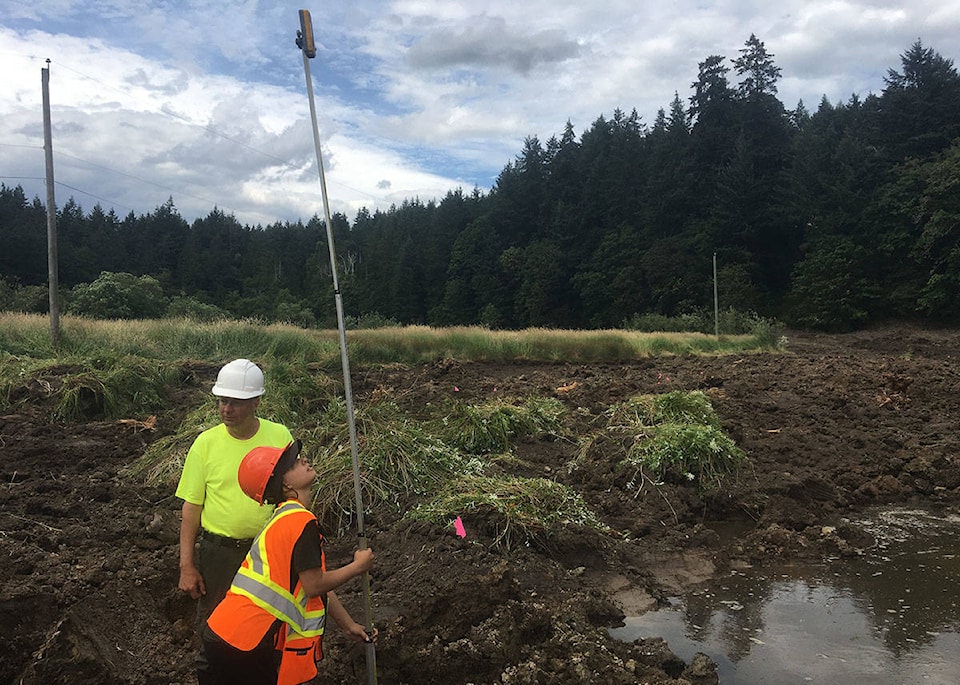The Nature Conservancy of Canada has broken ground on an ambitious project to restore close to two hectares of wetlands in the Cowichan Estuary.
The wetlands are in the low-lying section of NCC’s Chase Woods Nature Preserve, at the base of Mount Tzouhalem. Before being drained and converted to agricultural use, these marsh wetlands connected to the Cowichan Estuary and provided important habitat for rearing salmon and for waterfowl in the winter.
With approximately 60 per cent of shoreline marsh habitats in the Salish Sea having been lost, opportunities to restore these ecosystems are rare and important. The drained marshes on the Chase Woods Nature Preserve provide an exciting opportunity for coastal wetland habitat restoration.
Under the direction of wetland specialists Robin Annschild and Tom Biebighauser, and working with Cowichan Tribes and the Province of B.C., the project broke ground on June 25, after two years of planning and development. Pontius Brothers Contracting are operating the heavy equipment required to execute an earth-moving project of this size and scope.
This first phase of the restoration focuses on re-creating the historical slow and winding path of a creek that had long ago been diverted into a deep ditch in order to drain the marshland through which it flowed.
The transformation is well underway, including:
• mowing and removal of reed canary grass and Himalayan blackberry (invasive plant species) with scalping of the top soil layer on more than 50 per cent of the project area;
• removal of fill and refuse left over from previous agricultural and residential use;
• removal of a well and installation of a vertical grade structure at the stream entrance to the wetlands to prevent erosion;
• creation of six wetland ponds and the initial stages of the stream that will meander through them on 30 per cnet of the restoration area;
• addition of woody debris to future wetland sites and transplanting of native plant species.
“We are making good progress,” said Jocelyn Wood, West Coast stewardship coordinator with the Nature Conservancy of Canada. “The site is dry at the moment — perfect working conditions for heavy equipment and minimal disturbance to wildlife. It looks chaotic — think of your kitchen midway through baking a cake — but within the next 12 to 24 months the area will really come to life.”
Prior to breaking ground, archaeological impact assessments were undertaken through soil test pits. Archaeologist Genevieve Hill and Cowichan Tribes cultural monitor Harold Joe are providing direct and ongoing oversight throughout the project.
By July 6 the major works will be complete with the removal of the rest of the invasive species, construction of additional wetland pools and complete reconstruction of more than 300 metres of Holden Creek into a sinuous stream that transports water throughout the project area. Adding more woody debris, completing erosion control structures and seeding the restoration area will wrap up the first phase of reconstruction.
The next step is simply waiting for water and wildlife to return. NCC will monitor the vegetation, erosion and winter/spring bird species to document the significant changes to the former hayfield and assess next steps or updates to the site.
Over the coming months NCC will host several volunteer events to collect native plant seed and distribute them in the restoration area, as well as planting shrubs and trees. To find out more visit www.natureconservancy.ca/bc.
Funding for the Chase Woods Wetland Restoration Project came from the Katzaa Foundation, the WC Kitchen Foundation, the Coca-Cola Foundation and the Pure Green Earth Fund.
